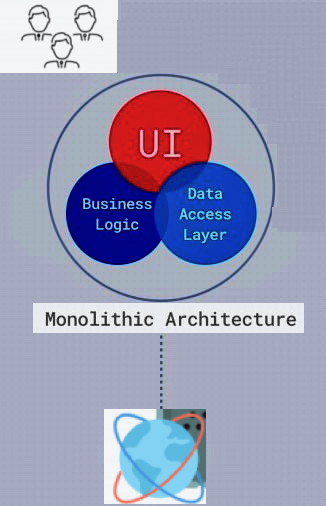What is Microservices: Basic Understanding

Microservices is often explained as an architecture style where an application is decomposed into independent services. Microservices is an architecture in which different component pieces of a software design are created and housed as individual, isolated services. Each is deployed separately and they communicate through well-defined network-based interfaces. Microservices are intended to be “small” (loosely defined) and kept to a single bounded context.
Benefits to Microservices
isolation and strict requirement to communicate through well-defined interfaces, microservices prevent quick and dirty solutions often found in monoliths. These hacks inside of a monolith result in a loss of cohesion and an increase in coupling — two primary causes of complexity.
Architecture
There 2 types of architecture
Monolithic Architecture
The Monolithic application describes a single-tiered software application in which different components combined into a single program from a single platform.

Microservices Architecture
Application development in which a large application is built as a suite of modular services (i.e. loosely coupled modules/components). Each module supports a specific business goal and uses a simple, well-defined interface to communicate with other sets of services.
Resulting context
The large monolithic code base intimidates developers, especially ones who are new to the team. The application can be difficult to understand and modify. As a result, development typically slows down. Also, because there are not hard module boundaries, modularity breaks down over time.
Overloaded IDE – the larger the code base the slower the IDE and the less productive developers are.
Overloaded web container – the larger the application the longer it takes to start up. This had have a huge impact on developer productivity because of time wasted waiting for the container to start. It also impacts deployment too.
Continuous deployment is difficult – a large monolithic application is also an obstacle to frequent deployments. In order to update one component you have to redeploy the entire application. This will interrupt background tasks (e.g. Quartz jobs in a Java application), regardless of whether they are impacted by the change, and possibly cause problems.
Scaling the application can be difficult – a monolithic architecture is that it can only scale in one dimension. On the one hand, it can scale with an increasing transaction volume by running more copies of the application. Some clouds can even adjust the number of instances dynamically based on load.
Obstacle to scaling development – A monolithic application is also an obstacle to scaling development. Once the application gets to a certain size its useful to divide up the engineering organization into teams that focus on specific functional areas. For example, we might want to have the UI team, accounting team, inventory team, etc.

Resulting context
This solution has a number of benefits:
- Enables the continuous delivery and deployment of large, complex applications.
- Improved maintainability – each service is relatively small and so is easier to understand and change
- Better testability – services are smaller and faster to test
- Better deployability – services can be deployed independently
- It enables you to organize the development effort around multiple, autonomous teams. Each (so called two pizza) team owns and is responsible for one or more services. Each team can develop, test, deploy and scale their services independently of all of the other teams.
- Each microservice is relatively small:
- Easier for a developer to understand
- The IDE is faster making developers more productive
- The application starts faster, which makes developers more productive, and speeds up deployments
- Improved fault isolation. For example, if there is a memory leak in one service then only that service will be affected. The other services will continue to handle requests. In comparison, one misbehaving component of a monolithic architecture can bring down the entire system.
- Eliminates any long-term commitment to a technology stack. When developing a new service you can pick a new technology stack. Similarly, when making major changes to an existing service you can rewrite it using a new technology stack.
————————-
